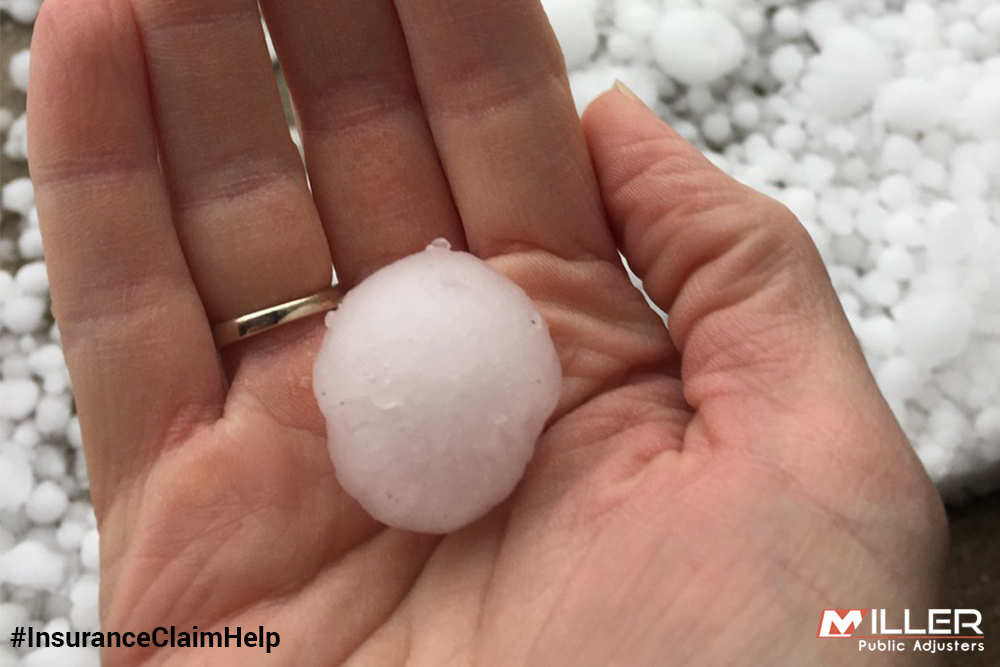
When a hailstorm strikes, it can batter roofs, shred screens and siding, and smash windows. Getting fully compensated for even glaring hail damage from your commercial, BOP or homeowners insurance policy is a challenge. Achieving a fair settlement for anything less than glaring damages can be a nightmare.
Factors in hail damage
Storm path
Hail falls in paths called hail swaths that are observable on radar. The fallout can be confined to less than an acre, or a hail swath can be 10 miles wide and 100 miles long. When large hail swaths pass over populated areas, the damage is costly — nearly $1 billion in the U.S. each year.
Hailstone size
If you cut a hailstone in half, you’ll notice it has rings similar to those you see when you cut down a tree. This is because hailstones start as tiny ice nuclei that bounce around inside a thunderstorm cell, rising and falling in the updrafts and downdrafts, accumulating layer after layer of ice, until they grow too heavy and fall to earth.
The largest recorded hailstone in the U.S. fell from a super cell passing over South Dakota in 2010. The National Oceanic and Atmospheric Administration confirmed the stone measured eight inches across, with a circumference of 18.625 inches, and weighed nearly 2 pounds.
Of course, a hailstone doesn’t have to be the size of a volleyball to cause damage. The National Weather Service defines severe hail as stones measuring at least 1 inch in diameter (increased from 3/4 inch in 2010).
Wind speed
Insurance carriers work hard to limit coverage for hail damage caused by hailstones measuring less than 1 inch, sometimes even alleging their policyholders caused the damage themselves. The fact is, even pea-sized hailstones can do significant damage when propelled by strong winds.
Ten hits per 10’X10’ area
An insurance company adjuster may propose anything from a patch job to the full replacement of a hail-damaged roof or wall, depending on how many hits they count in a 10-foot square. For example, if there are 10 or more hits in a measured square on a hail-damaged roof, that entire slope should be replaced. As that number falls from 10+ hits/square, a patch job becomes the more likely proposal.
Factors in your hail damage insurance claim
Mitigate additional damage
All homeowners, BOP and commercial insurance policies require policyholders to protect their property from additional damage by making appropriate temporary emergency repairs. This is a no-excuses requirement, as property insurance policies provide coverage for mitigation work done by a professional contractor.
Give prompt notice of damage
All property insurance policies also require policyholders give prompt notice of any damage to the insured property. Even if you only suspect you have hail damage, report it to your insurance company immediately, and get a claim number. Delays in reporting hail damage raise suspicion about the validity of the damage, and can result in a claim denial or a reduction in your total settlement amount.
Get a proper inspection
When hail damages walls and windows, it’s usually easy to evaluate the extent of the loss. Damage to roofs, though, can be tricky to assess. Surely a large divot is obvious, but hail can damage the underlayment and deck, too. If your home or business was in the path of a hail swath, be sure you have a thorough inspection of your property done by a qualified, respected professional.
Repair or replace?
This is a key question in your hail damage insurance claim. Repairs cost less, so insurance adjusters often will recommend patching a roof, or repairing only the damaged portion of an exterior wall, versus replacing the whole. Some also will state the damage is cosmetic, which severely limits the claim settlement amount.
You not only have the right, you have the obligation to prove the full extent of your hail damages. Take several photographs from different angles of any damage. Also get at least two (three is better) estimates from reputable contractors who can substantiate your loss. You are not required to use any preferred providers recommended by your insurance company. Be sure you have the details in writing.
If your insurance company adjuster’s findings conflict with your contractor’s assessment, make sure you get everyone on site at the same time to resolve any differences about the extent of your damages, the cost of repairs, and whether or not all or part of those costs are covered under your policy.
Note: in the aftermath of a major hail event, traveling contractors may show up promising quick, inexpensive repairs. Be sure to check their references. Too often people are taken advantage of by con artists looking to make a quick buck off the vulnerability of others. Make certain you entrust your estimating and repair work only to reputable contractors who stand behind their work.
What to do if your hail damage insurance claim is denied
Consulting a licensed public insurance adjuster is always advised any time you suffer an insured property loss — especially if your claim is denied. A public adjuster is an expert at interpreting property insurance policies, verifying, documenting and valuing covered damages, negotiating for your maximum settlement offer, and serving as your exclusive advocate throughout the property insurance claim process.
Remember, hail events are costly and put pressure on both human resources and corporate profits. This pressure incentivizes insurance carriers to limit claim settlement amounts at every opportunity. If you accept a denial, that’s one less claim your insurance company has to settle.
Bringing in a public adjuster immediately after a hailstorm ensures your hail damage insurance claim is handled professionally, proactively, and with your best interests at the forefront every step of the way.
.png?width=190&height=55&name=MPA%20Logo%20Vector%20-%20Original%20(3).png)

.webp?width=331&height=382&name=ResourcesCTA-Fin-001%20(1).webp)



